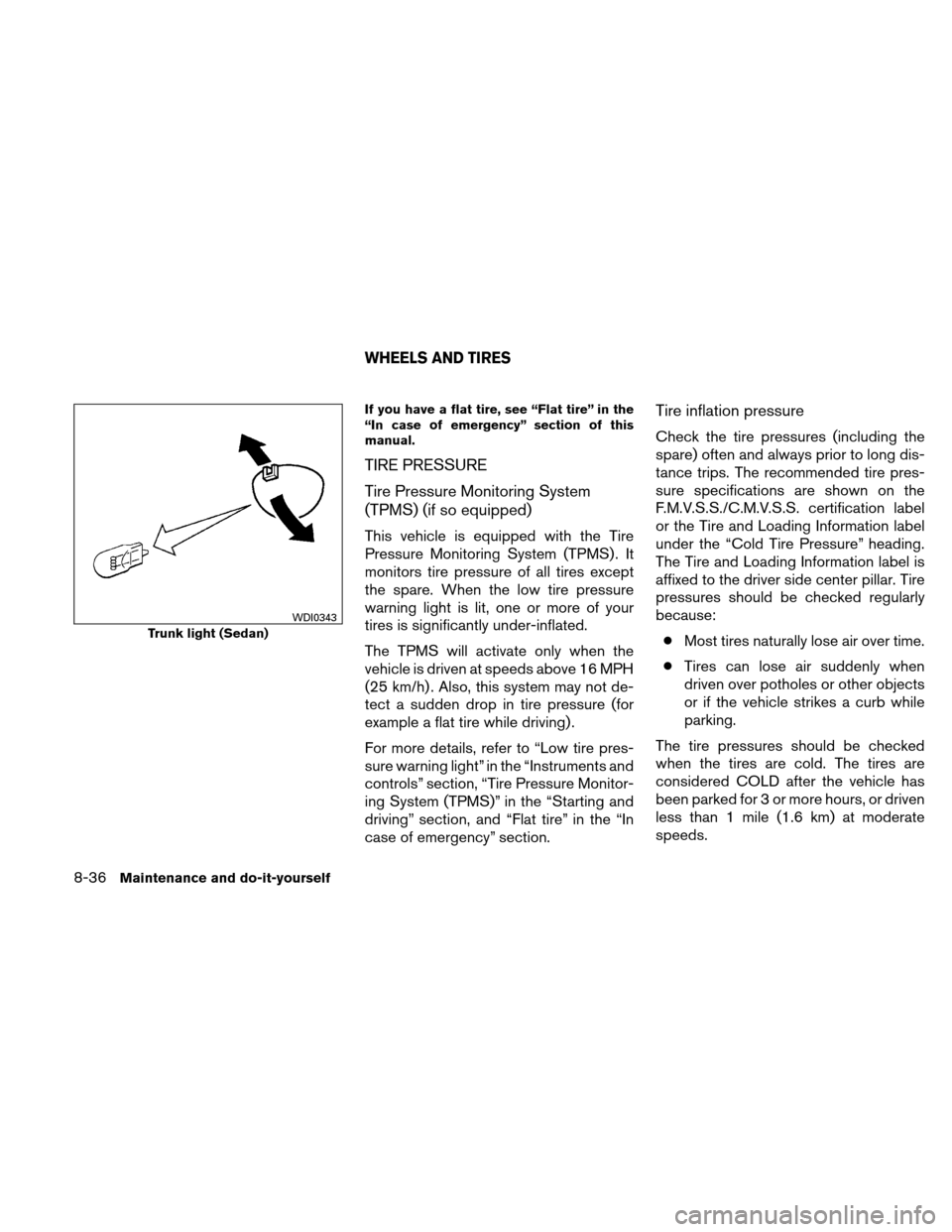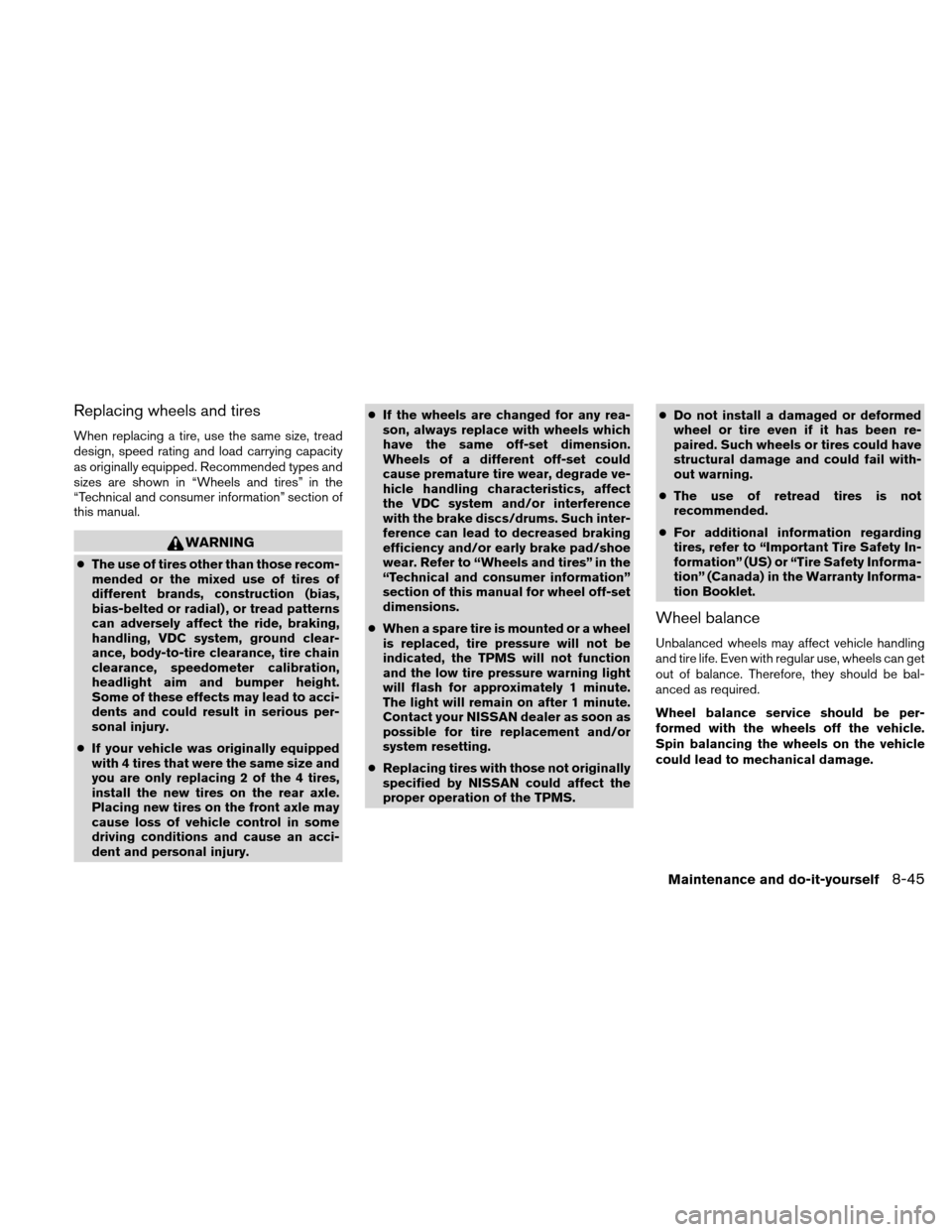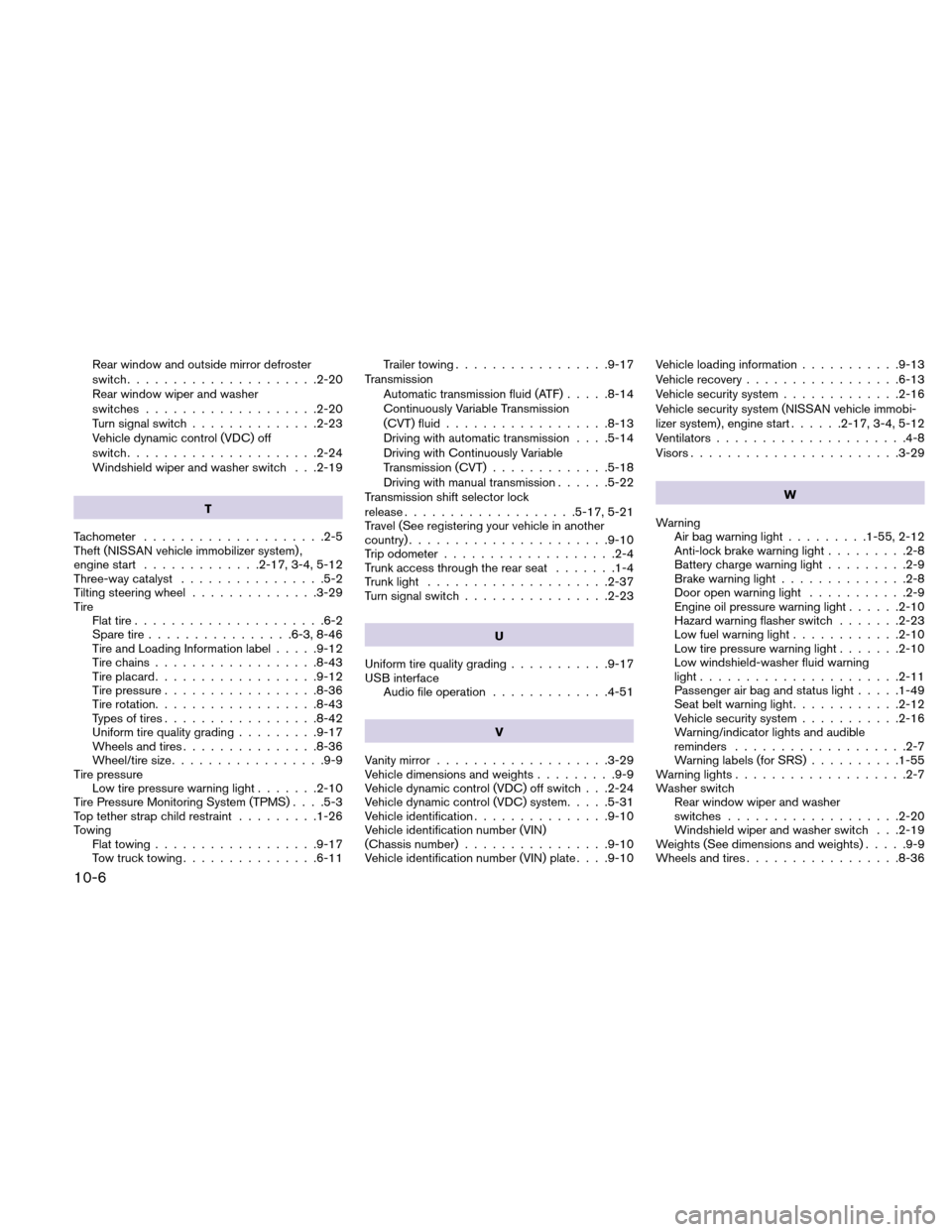2011 NISSAN VERSA HATCHBACK TPMS
[x] Cancel search: TPMSPage 309 of 350

If you have a flat tire, see “Flat tire” in the
“In case of emergency” section of this
manual.
TIRE PRESSURE
Tire Pressure Monitoring System
(TPMS) (if so equipped)
This vehicle is equipped with the Tire
Pressure Monitoring System (TPMS) . It
monitors tire pressure of all tires except
the spare. When the low tire pressure
warning light is lit, one or more of your
tires is significantly under-inflated.
The TPMS will activate only when the
vehicle is driven at speeds above 16 MPH
(25 km/h) . Also, this system may not de-
tect a sudden drop in tire pressure (for
example a flat tire while driving) .
For more details, refer to “Low tire pres-
sure warning light” in the “Instruments and
controls” section, “Tire Pressure Monitor-
ing System (TPMS)” in the “Starting and
driving” section, and “Flat tire” in the “In
case of emergency” section.
Tire inflation pressure
Check the tire pressures (including the
spare) often and always prior to long dis-
tance trips. The recommended tire pres-
sure specifications are shown on the
F.M.V.S.S./C.M.V.S.S. certification label
or the Tire and Loading Information label
under the “Cold Tire Pressure” heading.
The Tire and Loading Information label is
affixed to the driver side center pillar. Tire
pressures should be checked regularly
because:● Most tires naturally lose air over time.
● Tires can lose air suddenly when
driven over potholes or other objects
or if the vehicle strikes a curb while
parking.
The tire pressures should be checked
when the tires are cold. The tires are
considered COLD after the vehicle has
been parked for 3 or more hours, or driven
less than 1 mile (1.6 km) at moderate
speeds.
Trunk light (Sedan)
WDI0343
WHEELS AND TIRES
8-36Maintenance and do-it-yourself
Page 318 of 350

Replacing wheels and tires
When replacing a tire, use the same size, tread
design, speed rating and load carrying capacity
as originally equipped. Recommended types and
sizes are shown in “Wheels and tires” in the
“Technical and consumer information” section of
this manual.
WARNING
●The use of tires other than those recom-
mended or the mixed use of tires of
different brands, construction (bias,
bias-belted or radial) , or tread patterns
can adversely affect the ride, braking,
handling, VDC system, ground clear-
ance, body-to-tire clearance, tire chain
clearance, speedometer calibration,
headlight aim and bumper height.
Some of these effects may lead to acci-
dents and could result in serious per-
sonal injury.
● If your vehicle was originally equipped
with 4 tires that were the same size and
you are only replacing 2 of the 4 tires,
install the new tires on the rear axle.
Placing new tires on the front axle may
cause loss of vehicle control in some
driving conditions and cause an acci-
dent and personal injury. ●
If the wheels are changed for any rea-
son, always replace with wheels which
have the same off-set dimension.
Wheels of a different off-set could
cause premature tire wear, degrade ve-
hicle handling characteristics, affect
the VDC system and/or interference
with the brake discs/drums. Such inter-
ference can lead to decreased braking
efficiency and/or early brake pad/shoe
wear. Refer to “Wheels and tires” in the
“Technical and consumer information”
section of this manual for wheel off-set
dimensions.
● When a spare tire is mounted or a wheel
is replaced, tire pressure will not be
indicated, the TPMS will not function
and the low tire pressure warning light
will flash for approximately 1 minute.
The light will remain on after 1 minute.
Contact your NISSAN dealer as soon as
possible for tire replacement and/or
system resetting.
● Replacing tires with those not originally
specified by NISSAN could affect the
proper operation of the TPMS. ●
Do not install a damaged or deformed
wheel or tire even if it has been re-
paired. Such wheels or tires could have
structural damage and could fail with-
out warning.
● The use of retread tires is not
recommended.
● For additional information regarding
tires, refer to “Important Tire Safety In-
formation” (US) or “Tire Safety Informa-
tion” (Canada) in the Warranty Informa-
tion Booklet.
Wheel balance
Unbalanced wheels may affect vehicle handling
and tire life. Even with regular use, wheels can get
out of balance. Therefore, they should be bal-
anced as required.
Wheel balance service should be per-
formed with the wheels off the vehicle.
Spin balancing the wheels on the vehicle
could lead to mechanical damage.
Maintenance and do-it-yourself8-45
Page 347 of 350

Rear window and outside mirror defroster
switch.....................2-20
Rear window wiper and washer
switches ...................2-20
Turn signal switch ..............2-23
Vehicle dynamic control (VDC) off
switch .....................2-24
Windshield wiper and washer switch . . .2-19
T
Tachometer ....................2-5
Theft (NISSAN vehicle immobilizer system) ,
engine start .............2-17, 3-4, 5-12
Three-way catalyst ................5-2
Tilting steering wheel ..............3-29
Tire Flat tire .....................6-2
Spare tire ................6-3, 8-46
Tire and Loading Information label .....9-12
Tire chains ..................8-43
Tire placard ..................9-12
Tire pressure .................8-36
Tire rotation ..................8-43
Types of tires .................8-42
Uniform tire quality grading .........9-17
Wheels and tires ...............8-36
Wheel/tire size .................9-9
Tire pressure Low tire pressure warning light .......2-10
Tire Pressure Monitoring System (TPMS) . . . .5-3
Top tether strap child restraint .........1-26
Towing Flat towing ..................9-17
Tow truck towing ...............6-11 Trailer towing
.................9-17
Transmission Automatic transmission fluid (ATF) .....8-14
Continuously Variable Transmission
(CVT) fluid ..................8-13
Driving with automatic transmission . . . .5-14
Driving with Continuously Variable
Transmission (CVT) .............5-18
Driving with manual transmission ......5-22
Transmission shift selector lock
release ...................5-17, 5-21
Travel (See registering your vehicle in another
country) ......................9-10
Trip odometer ...................2-4
T runk
access through the rear seat .......1-4
Trunk light ....................2-37
Turn signal switch ................2-23
U
Uniform tire quality grading ...........9-17
USB interface Audio file operation .............4-51
V
Vanity mirror ...................3-29
Vehicle dimensions and weights .........9-9
Vehicle dynamic control (VDC) off switch . . .2-24
Vehicle dynamic control (VDC) system .....5-31
Vehicle identification ...............9-10
Vehicle identification number (VIN)
(Chassis number) ................9-10
Vehicle identification number (VIN) plate . . . .9-10 Vehicle loading information
...........9-13
Vehicle recovery .................6-13
Vehicle security system .............2-16
Vehicle security system (NISSAN vehicle immobi-
lizer system) , engine start ......2-17, 3-4, 5-12
Ventilators .....................4-8
Visors .......................3-29
W
Warning Air bag warning light .........1-55, 2-12
Anti-lock brake warning light .........2-8
Battery charge warning light .........2-9
Brake warning light ..............2-8
Door open warning light ...........2-9
Engine oil pressure warning light ......2-10
Hazard warning flasher switch .......2-23
Low fuel warning light ............2-10
Low tire pressure warning light .......2-10
Low windshield-washer fluid warning
light ......................2-11
Passenger air bag and status light .....1-49
Seat belt warning light ............2-12
Vehicle security system ...........2-16
Warning/indicator lights and audible
reminders ...................2-7
Warning labels (for SRS) ..........1-55
W arning
lights ...................2-7
Washer switch Rear window wiper and washer
switches ...................2-20
Windshield wiper and washer switch . . .2-19
Weights (See dimensions and weights) .....9-9
Wheels and tires .................8-36
10-6